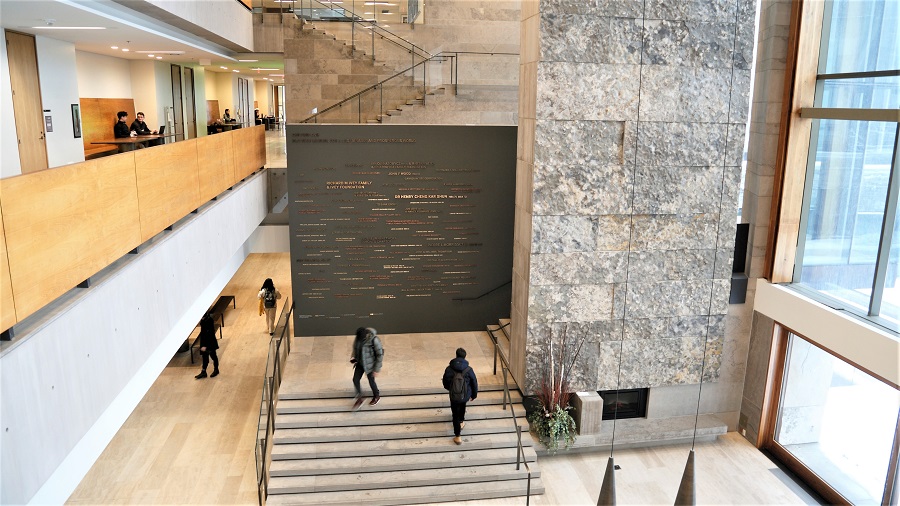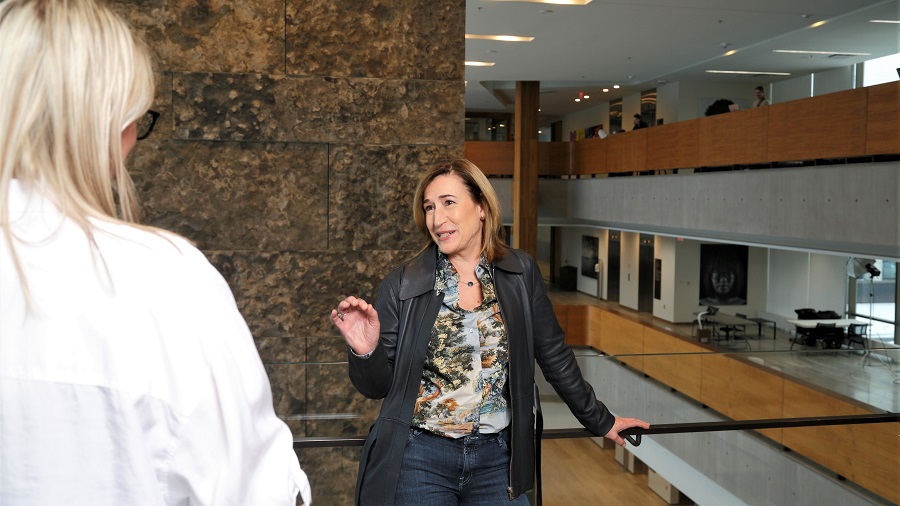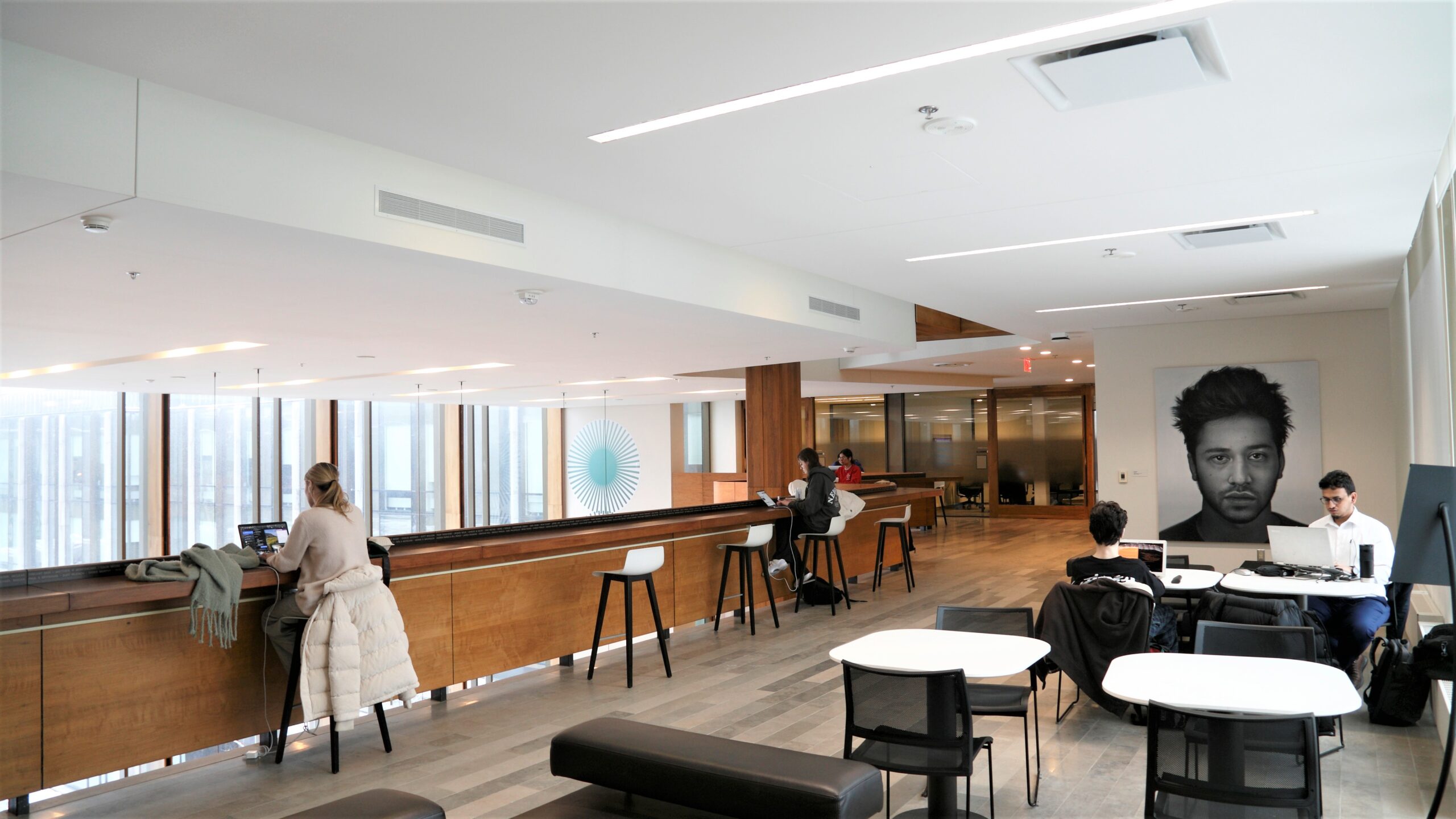Ivey at 100
As Ivey Business School celebrates its centennial, it looks toward the big ideas that will shape the next 100 years
Photo: Ivey Business School dean, Sharon Hodgson
WHEN THE TIME came to rebrand the Wortley Village café they had purchased, Mano Majumdar and Richie Bloomfield seriously considered the name ‘Thesis’. As funky coffee shop names go, it’s pretty good, but they liked it for a different reason.
Click here to view this story in magazine format
Having both earned MBAs at Ivey Business School, they sometimes lamented the fact that so many grads went into banking and financial sectors. “We thought a Main Street business could benefit from what we had learned,” Bloomfield recalls. “We talked about buying a business. It would kind of be our real-world dissertation.”
They struck a deal to buy the café from Fire Roasted Coffee Co., which was leaving the restaurant sector and focusing on its roasting business. When the two friends took possession in November 2019, ‘Sidetrack, A Wortley Café’ edged out ‘Thesis’. But the concept of implementing the lessons they’d learned (and later taught in the school’s Business Foundations group) continued to intrigue them.
Story Continues Below
The pair are among thousands of students who have been challenged, intimidated, inspired and, ultimately, educated within the framework of Ivey’s famous case method of teaching. Sidetrack is their living case, even as both work at other, full-time jobs.
Across Canada and around the world, there are Ivey grads doing a version of the same thing — applying the lessons learned in case discussions to the real world of their jobs and organizations. And as Ivey marks its 100th anniversary, the school is both looking back to celebrate its achievements and looking forward to the next decade and beyond, with a clear vision of how it can continue to be one of the world’s best and most influential business schools.

It isn’t only students who can feel overwhelmed by the sometimes-intense atmosphere the school engenders. “My first year teaching was dreadful,” recalls Jeffrey Gandz, who arrived in 1977 after working in marketing for Unilever and then earning his Ph.D. at York University. “Teaching with the case method was a challenge. I sometimes felt like a traffic cop with 70 students, trying to facilitate a conversation. I went to see the dean, Bud Johnston, and told him this wasn’t for me.”
Johnston, who had just been appointed dean, encouraged Gandz to stick around for a second year, to see if things improved. “In my second year, things flipped. I quickly came to love the place and what I was doing.” Gandz retired from active teaching in 2013 and is a professor emeritus. As such, he has been connected to the school for nearly half its 100 years of operation.
The beginning, as you might expect, was rather humble. But even before one student took one note, organizers decided to adopt the case method of teaching. There weren’t many business schools — or departments of commercial economics, as Ivey began life — from which to draw inspiration. But there was one place that seemed to be doing things right and getting results: Harvard. It was using the case method, and that was good enough for Western. Classes began in 1922; the following year, the first six students graduated with honours business administration degrees.
“If it hadn’t been for the pandemic, I’m not sure we would have gotten to where we are today. We had to stop everything during lockdown, and that gave us a chance to start again, to change the structure of what we were doing” —Sharon Hodgson
The Harvard influence was profound and long-lasting. “When I arrived in 1977, there were roughly 40 faculty,” Gandz recalls. “And I would say 90 per cent of them had degrees from either Harvard or Ivey. Ivey was Harvard North.”
There are worse things to be called.
The school adopted the Ivey name in 1996, reflecting what then was already a four-decade association with the Ivey family. Indeed, Richard Ivey received an honourary degree in 1954, recognizing his work with the school. And in 1957, the new School of Business Administration building opened and was named in his honour.
Story Continues Below
For many in London, and even for Western students in other faculties, Ivey is symbolized almost entirely by its gorgeous glass-cube building. It opened officially 10 years ago, a crowning achievement for Carol Stephenson as she completed her second term as dean.
Stephenson’s influence continued after she left the dean’s chair. She played a central role in recruiting the current dean, Sharon Hodgson.
“Carol called me to discuss the job,” she recalls. “I was in Toronto, and we met at a restaurant halfway between Toronto and London in the summer of 2018. She walked me through the position and was very helpful.”
Hodgson, a Winnipeg native, had retired from IBM in 2017. She was looking for a new career direction and was being wooed by tech juggernaut Salesforce. “I interviewed in parallel for both positions and really thought I would take the Salesforce job at various times,” she recalls.

With due respect to all the Forest City has to offer, living in San Francisco had a lot of appeal. So too did the financial benefits. And yet, Hodgson felt a pull toward a job where she could make a tangible impact, where she could, quite literally, change the world. “I wanted to do something transformational and give back. My husband kept telling me I would be happier at Ivey.”
When she chose Ivey, she discovered one of her best friends had also been interviewing for the Salesforce job. Her friend got the job, and earlier this year, Hodgson’s son took a job in San Francisco. She will continue to have a Bay Area connection.
Installed in 2019, she had ambitious plans for her tenure and quickly began working to implement them. That’s when she discovered the many differences between academia and the private sector. She’d spent six months on a “listening tour,” meeting with faculty, students and staff and had established a committee to begin crafting a new strategic plan, what eventually would be known as Ivey Next.
But it didn’t go as she had hoped.
Gandz could have told her — or any other dean for that matter — how difficult it would be. “For the most part, you come in and you can’t fire or hire anyone. You can’t tell people what to do. You’re working for them, versus them working for you. It’s a herding cats type of job,” he says. “The smart ones figure out what they can do and what can be left to others. They manage relations, understanding the department is a living organism, and try to anticipate and initiate change, rather than just being reactive.”
Story Continues Below
Hodgson likely heard something similar from Stephenson, but it wasn’t until she was in the job that she understood what was needed.
“If it hadn’t been for the pandemic, I’m not sure we would have gotten to where we are today,” she says, frankly. “We had to stop everything during lockdown, and that gave us a chance to start again, to change the structure of what we were doing.”
She expanded the committee, inviting more faculty to participate in the process. The result, concluded in March, 2022, is the ambitious Ivey Next strategic plan. The purpose statement, “Inspiring leaders for a sustainable and prosperous world,” hints at the overall goals, but three critical issues identified in the plan give a better idea of where Ivey is heading.
They are: evolution of work; sustainability; and Canada’s place in the world. Each area is huge and encompasses many areas of teaching and research. They represent issues being discussed by business, government and citizens. And those are the crossroads where Ivey grads will be situated in the coming years, with not just the opportunity to effect meaningful change, but perhaps even the moral imperative.
Story Continues Below
“If we want to change the world, these are the areas where things need to be implemented, where boards, CEOs and the public are all looking for solutions.”
Hodgson cannot — and does not want to — instruct faculty to direct their research projects to these areas. But in setting long-term goals, the school can shift toward those areas over time and perhaps connect ongoing research to new projects and solutions.
Ivey Next also promises a new approach to case method teaching, using technologies to present cases in new ways. Since cases arrived 100 years ago, the model has been much the same: Read the case, analyse the issues, discuss in class. Rinse and repeat.
“What if we could use something like augmented reality to present cases in a more immersive way?” Hodgson asks. “What if students could virtually walk on the factory floor and see the challenges, see actual bottlenecks, rather than just reading about them?”

And why does learning have to require verbal feedback among a large class of students, all eager to speak to earn important participation grades? That’s certainly what Gandz wondered in 1977, when he felt like a harried traffic cop, rather than a learned professor giving students the benefit of his experience.
Rethinking the way participation is rewarded is part of a larger goal of continuing to be more inclusive. “In my first year, in a class of 70 there were six women and no visible minorities. We were white and male,” Gandz recalls. The strategic plan lays the groundwork to continue expanding inclusivity, broadening the definition, and finding new ways to reach out.
The 100th anniversary celebrations are centred on Global Ivey Day, May 11, when alumni worldwide will do something good for their community. The school plans to plant 100 trees, working with ReForest London, and is in discussion with additional organizations regarding projects for later in the year.
But when the streamers come down and the balloons are gone, Ivey students will continue their community work. The well-established Ivey Field Project pairs students with local businesses that need some advice or expertise to solve a specific challenge. And MBA students participate in an annual Social Impact Day, volunteering with not-for-profits.
Story Continues Below
From his point of view, working full-time at Deloitte while running the real-life coffee shop case with Bloomfield, Mano Majumdar is encouraged by the direction and goals Ivey has identified. He sees them as crucial.
“If we are to be the leaders we see ourselves as, we have to be willing to go first and model these principles in our own processes,” Majumdar says. “We have done it before with the case method and the one-year MBA and stood apart from our peers. For the next hundred years, I wish Ivey the continued courage to move first and be radical.”
It’s a sentiment Hodgson endorses. It’s why she chose London over San Francisco: to change the world. ![]() Christopher Clark
Christopher Clark

